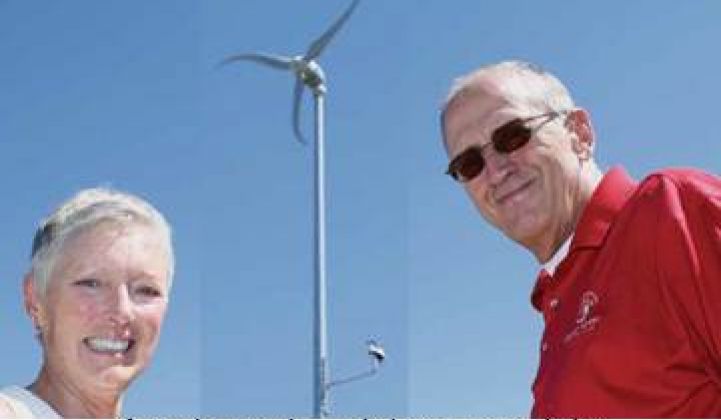To get a third of its power from renewables by 2020, California will need all its incentives working effectively. Many conservatives are generally disinclined to believe that possible, and the Brown administration is determined to prove them wrong.
The California Energy Commission (CEC) took a big step toward cleaning up a mess that has been troubling the small wind business since last spring. Newly revised guidelines for its Emerging Renewables Program (ERP), which the commission has just approved, eliminate shortcomings that were allowing abuses of the incentive described by some in the small wind business as fraud.
The taxpayer-funded ERP rebate was based on the rated power of small wind systems. The program allowed turbine manufacturers to self-certify power output and put no limit on the allowed portion of the system cost rebated to the purchaser.
As reported in previous Greentech Media investigative pieces, power data submitted to the CEC by DyoCore, Inc., which CEC spokeswoman Amy Morgan said it subsequently admitted was inaccurate, allowed DyoCore system purchasers to be reimbursed for up to 100 percent of the cost of its rooftop wind turbines. This created at least the appearance of fraud.
“Approximately 33 systems using DyoCore turbines have been installed and $515,385 in rebates paid,” according to the CEC’s Morgan. Because the CEC did not want to penalize consumers for bad acts that DyoCore had perpetrated, that taxpayer money will not be recovered.
Morgan added, “249 rebates reservations for systems using DyoCore turbines were approved, but not paid.” Rebate funds will be made available “for actual and provable costs incurred as of October 11, 2011, to consumers, retailers, and distributors, including finance and interest charges.”
The CEC expects rebates for this category of system purchasers to be between $4 million and $6 million.
There are another 455 completed applications for rebates on DyoCore turbine systems. For the next 180 days, those applicants may re‐apply and resume their place in the rebate queue but must choose a turbine that meets standards set by the new guidelines.
The newly revised guidelines set a limit on funding of rebates for the ERP at $20 million, half for fuel cells and half for small wind systems. The $4 million to $6 million allotted for previous applications will not come out of this money but from money budgeted for the previous program.

Initiated in 1998 to drive growth of under-30-kilowatt solar, wind and fuel cell systems, the ERP was the first such U.S. incentive. Though the Schwarzenegger administration developed bigger programs for solar, ERP’s $8.7 million in rebates helped build 577 small wind systems in California, with a cumulative installed capacity of 3.6 megawatts.
In keeping with California’s ambitious renewables goals, the long-standing $2.50 per watt ERP rebate (for the system’s first 10 kilowatts) was, in April 2010, increased to $3.00 per watt for one year to spur further growth. Shortly after the higher rebate went into effect, increased application rates began to raise questions, especially because they were accompanied by promises to consumers that the entire system cost could be rebated.
The self-certified productivity claims from DyoCore that allowed its customers to apply for 100 percent rebates, industry experts testified to the CEC, violated the laws of physics.
“They have a five-foot-diameter turbine that they mount on a roof,” Mike Bergey, President of the Distributed Wind Energy Association (DWEA) and of Bergey Windpower, an internationally respected small wind company, explained at the time. “They have paperwork that shows it produces 1.6 kilowatts at a wind speed of eight meters per second.” That, Bergey went on, is “over four times the total kinetic energy at that wind speed with that rotor diameter and about nine times the efficiency of the best-performing small wind turbine on the market.”

The CEC’s newly approved guidelines for the ERP make a variety of tweaks to the program and two crucial changes to eliminate such abuses, according to Morgan.
First, rebates cannot be more than 50 percent of the cost of a small wind system, and, second, turbine manufacturers will no longer be allowed to self-certify.
To be eligible for the CEC rebate, the power output of a small wind system must, Morgan said, have third-party certification by (1) the International Electrotechnical Commission (IEC), (2) the Small Wind Certification Council (SWCC) of the American Wind Energy Association (AWEA), or a Nationally Recognized Testing Laboratory (NRTL) such as Intertek.
Though the disposition of the DyoCore matter is a vital step toward cleaning up abuses in the state’s incentive program, the CEC’s decision on the size and duration of the rebate for small wind systems may, going forward, be determinative for the industry’s near-term success.
DWEA, small wind’s advocacy organization, wanted the commission to reinstitute the $3.00 per watt rebate for another full year to restart the stalled small wind market. The commission chose to extend it for 120 days, beginning November 2, 2011. The possibility of increasing that to 180 days, according to CEC spokeswoman Morgan, will be taken up at its November 16 meeting.
“DWEA has pointed out the damage the nine-month suspension of the rebate program has done,” Bergey noted after the CEC decision was announced. The small wind industry does “appreciate the CEC extending the $3.00 per watt level for 120 days, and possibly 180 days, rather than the 30 days they originally proposed,” he added, but “we hope that 120 or 180 days will be sufficient.”



